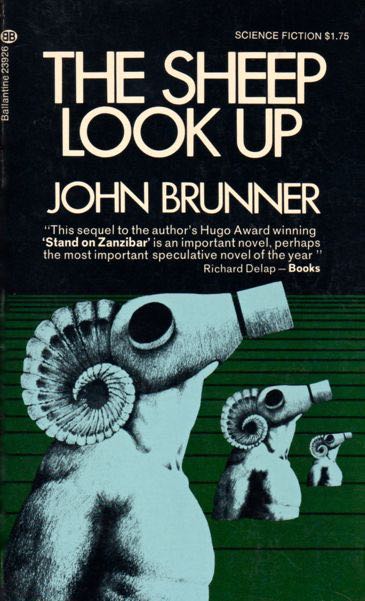The Sheep Look Up
Reviewed date: 2006 Jan 7
Rating: 4
425 pages
The British master strikes again with The Sheep Look Up. Stylistically it is similar to Stand On Zanzibar: it is the shotgun approach to portraying a society. Instead of a dozen chapters, the book is split into hundreds of discrete segments, each showing either part of the plot or part of the culture. The culture segments are advertisements, news reports, overheard conversations, and public notices. The plot segments follow any of a large number of characters, which serves to show a broad cross-section of society.
The premise of The Sheep Look Up is that the Earth is dying from pollution and over-consumption of natural resources. Oceans, lakes, and rivers are clogged; the land is filled with a hundred years of discarded industrial and nuclear waste; the air is so bad that nobody ventures out of doors without a filtermask. Homes have running water but it is rarely safe to drink. Vermin have adapted to all the pesticides and poisons used against them, and mutant bugs are destroying crops all over the world. America's biggest import is oxygen and its biggest export noxious gases. It is the worst nightmare of the 1960s environmentalists come true.
Although there are dozens of characters, there are only two main plotlines. The first centers around a batch of food sent to starving Africans. The food is Nutripon, a cassava-based substance invented by the rich philanthropist Jacob Bamberly. The Nutripon is somehow tainted with a hallucinatory drug that causes the African refugees to go crazy. This becomes of interest to the U.S. government because 1) it damages the already-low international reputation of the United States, and 2) American crops are failing and it appears Nutripon may soon be the only food available.
The second main story revolves around activist Austin Train, who starts an environmental movement whose ranks quickly run into the millions. But his Trainite followers, for all their demonstrations, accomplish little. Train wishes to make a real difference and hopes to save the world before it becomes unable to support human life.
Some people claim The Sheep Look Up is a communist novel. Not so: although it does show that unbridled capitalism together with public ownership of property results in the tragedy of the commons, it never advocates communism as the solution. In fact the hippie communalist wing of the Trainite movement is shown to be an ineffective and useless reaction to the environmental problems.
Others have said the book is anti-American. Again, this is mistaken: the book's action centers in America, but it is mentioned more than once that Europe is in similar straits.
Another common sentiment is that the book is anti-government. This is only partly true. In The Sheep Look Up the government is often blamed for particular acts of pollution and destruction, and often the government is indeed responsible. But some of the most dire problems arise despite the government's best efforts to prevent them: pesticides and poisons are strictly regulated to prevent them from being over-used and misused. Unfortunately the public ignores the government's warnings and uses black market pesticides anyway, thus poisoning the environment and leading quickly to a new generation of mutant vermin that are unaffected by the chemicals.
One final comment that often surfaces is the claim that "President Prexy is the novel is a dead ringer for Reagan/Bush/[insert President here]." The people who say that are the same people who see Revenge of the Sith as social commentary about George W. Bush, and who think Antitrust is an accurate portrayal of Bill Gates and Microsoft.
While an excellent book, The Sheep Look Up has a few problems: its shotgun approach to storytelling is sometimes hard to follow. And John Brunner takes a few cheap shots at religion. But on the balance, this is an excellent novel. It is better than the more famous Stand on Zanzibar.
